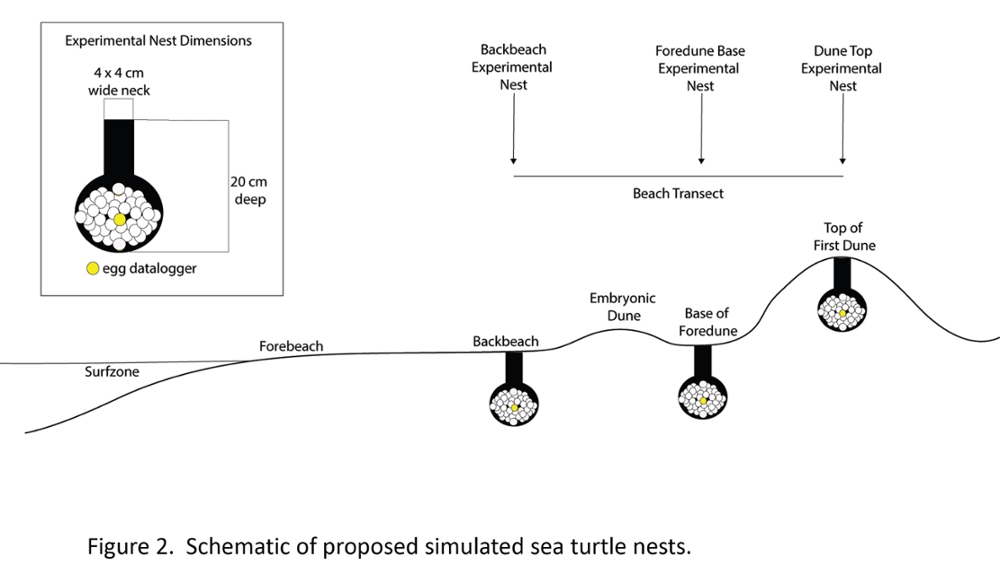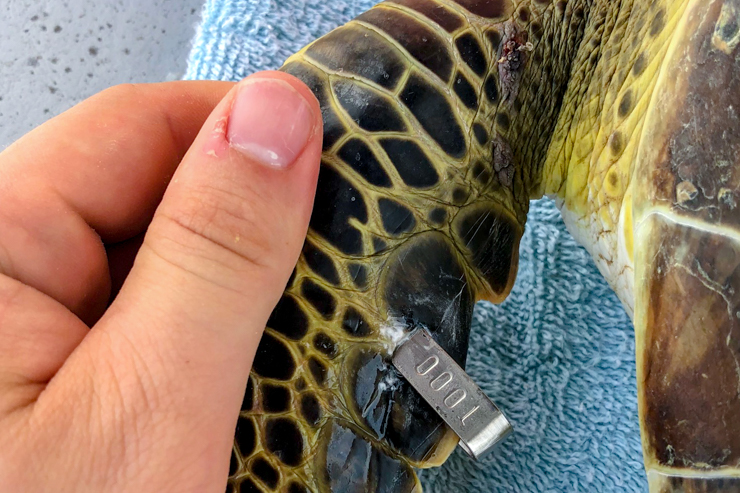Assessment of Optimal Sea Turtle Nesting Sites Along the Texas Coast
Funded by the TGLO – Coastal Management Program
Christopher D. Marshall, Ph.D.
Texas A&M University, Galveston Campus
Gulf Center for Sea Turtle Research
Research Objectives:
Beach re-nourishment and dune restoration projects can directly impact the quality of sea turtle nesting habitats. Although some recent work has been conducted, what comprises optimal sea turtle nesting habitat in Texas is still poorly understood. The proposed work will fill an important data gap and serve as a guide for future beach restoration projects on the upper TX coast. This work will ensure that optimal nesting habitat is provided for endangered Kemp’s ridley (Lepidochelys kempii) and other sea turtle species. Understanding the variables that determine optimal nesting sites is key to the conservation and restoration of Texas sea turtle populations. Kemp’s ridley sea turtles are the most critically endangered species in the world and are endemic to the western Gulf of Mexico. The upper Texas coast has seen a steady increase in nesting Kemp’s ridley sea turtles since 2002. However, the combination of extensive erosion and beach/dune restoration have negatively impacted nesting sites.
Our goal is to characterize successful nesting habitat on both natural and re-nourished beaches on the upper Texas coast and compare these metrics to the relatively optimal sea turtle nesting habit on the Padre Island National Seashore (PAIS), which receives the majority of the Texas Kemp’s ridley nests. The proposal objectives are to: 1) characterize the geomorphology and sand grain size distribution of beaches on the Bolivar peninsula (BP), Galveston (GI) and Follets Islands (FI) and 2) measure the temperature regime within simulated, experimental Kemp's ridley sea turtle nests at these same sites, where sea turtles are known to have nested. Simulated Kemp ridley nests will be created by hand-digging nest (20 cm (8 inch) deep and wide; with a 4 x 4 cm (1.5 x 1.5 inch) entrance). Our collaborator, Dr. Donna Shaver (National Park Service), will select 1 site at PAIS (a total of 7 nest sites). For BP, GI and FI, we will select two known nesting sites, which will include a combination of natural and re-nourished beaches. Each site will have 5 transects and for each transect, we will dig 3 simulated nests from mid-beach to upper beach (base of dune), for a total of 15 nests per site (a total of 105 nests across 7 sites). To replicate a natural nest, 100 "pseudo-turtle eggs" of the same dimensions as Kemp’s ridley eggs will be fabricated and placed in each nest with data-logger(s) to record temperature and humidity. To simulate natural conditions, no above ground markers will be used. Sediment samples will be collected at each site for grain-size distributions and a grid of beach elevation profiles will be collected at each site (prior to and after nest installation) using a RTK GPS equipped drone owned by TAMUG and operated by FAA licensed staff. A radio tag placed in each transect along with a drone documented GPS positions will aid in site relocation. Kemp’s ridley nesting season spans from April 1st to July 15th. We will collect data from March 1st-September 1st. This ensures that the entire potential nesting season and environmental conditions are captured. The experimental nests pose no issue to actual nesting sea turtles; the likelihood of a turtle nesting on top of an experimental nest is low considering the density of nests on the upper coast (13 nests over 72 miles of beach in 2019). Even so, simulated nest pose no threat to nesting sea turtles.

Public Benefit:
Effective sea turtle nesting habitat assessment will provide important information to ongoing efforts to re-nourish beaches and dune restoration as part of the planned coastal spine dune system project. Proper beach geomorphological, sand grain size and thermal environmental conditions are critical for sea turtle nesting. Therefore, this project will benefit the citizens of Texas by supporting effective ecosystem management based on the best available science. As sea turtle populations increase, increased nesting will bring increased tourism and environmental engagement of the local citizens who are becoming involved as stakeholders for sea turtles and marine conservation. Local citizens have been increasingly involved as stakeholders since Dr. Marshall took over as the lead on the Upper Texas Coast Sea Turtle Patrol (www.tamug.edu/seaturtlepatrol). This project will provide numerous training and research opportunities for Texas undergraduate and graduate students.
A diverse assemblage of sea turtles, of several life stages, inhabits estuarine and near-shore coastal habitats of Texas. Several life stages of Kemp’s ridley (Lepidochelys kempii), green (Chelonia mydas) and loggerhead (Caretta caretta) sea turtles are present in Texas waters and Texas is thought to be an important developmental and foraging habitat for these species.
In collaboration with the USGS and NPS Padre Island National Seashore, members of the Gulf Center for Sea Turtle Research are expanding an in-water capture and tagging program of sea turtles in Texas estuaries and coastal habitats.
The purpose of this research is to initiate a long-term monitoring mark-recapture program that will characterize the size and age class structure of Kemp’s ridley, green and loggerhead turtles as well as the movement, habitat use, and health of these turtles in Texas.
The work involves setting entanglement nets by boats at various locations on the Texas coast. Once nets are deployed they are continually monitored. Once captured sea turtles will receive flipper and PIT (passive integrated transponder) tags. The will be measured and weighed. Several will be fitted with either a satellite tag, acoustic tag or both.
This work is needed to address gaps in our understanding of sea turtle population demography (species, and size class), movement and habitat connectivity of Kemp’s ridley, green and loggerhead sea turtles. The information collected will greatly increase our knowledge of the natural history of several life stages of these sea turtles that will be useful for recovery plan development, updates, effective management and conservation.


During captures, each sea turtle’s health will receive a health assessment. We will conduct a 1) physical exam for broken bones, broken scutes, fishing hooks, epibont (barnacle) load and lacerations, 2) we will assess if FP (fibropapillomatosis) tumors are present on the turtle and score them 3) we will collect blood to establish baseline blood chemistry values, and we will collect measurements and weight to calculate a body condition index.
